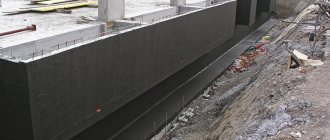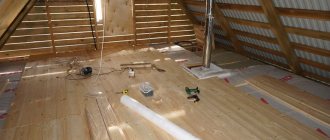Arrangement of heating of underground premises
Heating in the basement is designed to create an optimal temperature regime, which changes during its operation. As a rule, water or air systems are used. The loads of the basement heating system are determined based on the heat balance of the basement.
When the basement is not in use by the owner, a high temperature can be maintained without using a heater - at a depth of more than two meters, the temperature in some regions does not drop below - degrees Celsius.
Proper thermal insulation of basement walls keeps the temperature at a level of up to degrees Celsius without additional heating systems. In addition, communications and equipment also emit heat, which makes it possible to increase the temperature of the room.
Requirements for gas equipment in the basement
When installing gas boilers and other equipment, you must follow the rules for their installation and use. A gas boiler is installed if there is a boiler room in a private house. The installation of gas equipment in the underground areas of an apartment building is strictly prohibited.
The requirements for installing gas units are as follows:
- Ceilings in the room must be at least 2.5 meters;
- The basement area cannot be less than 4 square meters;
- Natural lighting must be provided, and for every ten square meters of the room there must be at least one window opening measuring 0.3 sq.m.;
- Doorways should be at least 80 centimeters in width;
- The basement must be equipped with high-quality ventilation;
- It is necessary to make a gas analyzer that can use an electric valve to turn off the gas supply in the event of a problem.
Operation of gas equipment in the basement must be carried out exclusively in accordance with the following rules:
- With open doors to the street,
- With a hood, the draft of which is at least three volumes of air per hour;
- The air flow is calculated by the sum of the exhaust volume with the amount of air required for burner operation;
- A window must be equipped.
Installation of a coaxial chimney for a gas boiler in the basement
As a rule, manufacturers supply this equipment along with the boiler. A classic hood is not required for such devices; combustion products will not be removed from the room.
The device is characterized by the presence of two tubes, which are located one inside the other without contact. They are taken outside. A larger channel is made to remove combustion products, and a small tube brings in fresh air.
The advantages of such a device.
Selection of heating devices
Optimal operation of the system is impossible without the required communications for the equipment. Installing a boiler room in a private house is a complex process, for which it is necessary to take care of the supply of gas, water supply, sewerage and electricity.
First of all, you need to take care of the installation of a single-phase electrical network, which has a standard rated voltage and a maximum current of 20 A. Another important condition is high-quality insulation of wires, grounding and installation of the machine.
If there is one boiler on the ground floor, then one shut-off unit will be sufficient. It is installed on the gas main. When installing two boilers, each unit will have to use a separate shut-off unit.
Care should be taken to connect the water supply to the general hot water supply and heating system. This will allow you to use the boiler room if other work needs to be done.
Condensation collects in the water supply system, ventilation system, chimney and boiler, so it is necessary to use a device that eliminates excess moisture. This issue cannot be ignored, since state standards contain regulated indicators for boiler rooms in the basement.
Main types of heating systems
We can immediately distinguish two main types of heating:
- Water heating of a private house, which involves installing radiators and a boiler (gas or electric).
- Stove heating, the organization of which requires the presence of a “potbelly stove” or stove.
Water heating operates on the basis of a boiler (it can be electric or gas). One of the main advantages of such a heating system is the constant availability of warm water.
Simple water heating system: 1- boiler; 2 - expansion tank; 3 - supply pipe; 4 - radiator; 5 - return pipe.
When installing stove heating, the installation of a “potbelly stove” or stove is required. This type of heating is more economical both during installation and during further use, which is its main advantage. In addition, in this case there is no need to look for a place to install a bulky boiler. The stove will produce enough heat to heat a small basement of a private house.
But for the system to operate effectively, it is necessary to provide a chimney. Here you need to approach the issue responsibly and accurately calculate the parameters of the pipes to organize sufficient traction.
Basement heating systems
The basement in a residential apartment building does not require a separate heating system - it already has collector pipes. But if the basement is used not only for the safety and placement of the main communication routes, but for organizing a store or any other establishment, then it is necessary to consider an additional heating system.
Diagram of a heating system in an apartment building
All basements in old-style apartment buildings were built from brick or concrete monolith. Brick itself is a cold building material, but if the room is well heated, it can maintain a constant temperature for a very long time.
Brick is a fairly durable material that can withstand temperature changes and heavy weight. Considering that an apartment building shrinks almost every year, the soil pressure on the basement increases each time. It is for this reason that in most cases the thickness of the walls of such a brick room is at least 50-60 cm.
Advice. It is especially important to make a high-quality cement mortar, with the help of which the building material will be held together. For this, special additives are used that give strength to the solution after it dries.
Since the walls are thick, they will be able to maintain a constant temperature in winter, but in summer this will be very problematic. In order to properly think through the heating system of the basement, it is worth pre-insulating its brick walls so that the heat does not escape outside.
The following can be used as a heat insulator:
- Styrofoam,
- polyurethane foam,
- mineral wool in mats,
- sobroizol and much more.
These materials have excellent technical characteristics. They are very dense and will not allow moisture to pass through, which comes out onto the inner surface of the wall due to temperature changes or as a result of soil freezing. They are quite easy to install using a special adhesive composition.
Advice. To properly insulate a basement, brick walls must be plastered.
Which heating method to choose
Heating a basement or cellar is a rather complicated issue. Here it is necessary to approach the issue of choosing the type of heating of the room as responsibly as possible, based on the wishes and requirements of the owner. For example, if you need to heat the basement in a seasonal home (that is, during the cold spring and autumn months), then installing a simple heater will be enough.
On the other hand, if you plan to turn the basement of a country house into a full-fledged living space, then it is necessary to arrange more efficient heating. The best option in this case seems to be installing a furnace or boiler. It is worth noting that for the installation of a gas boiler it is necessary to allocate a separate room, and its operation must be coordinated with the relevant services.
https://podvaldoma.ru
As a rule, multi-story buildings have a basement. Initially, the purpose of the basement was to create a place where heating system equipment and pipelines could be placed. Then they began to use it for storing anything technical, and then for storing vegetables, fruits, and pickles, as in a cellar. Recently, due to the high cost of space and rent, basements have begun to be used for completely different purposes.
High-quality thermal insulation in the basement will ensure less heat loss.
The ground floor can often be seen converted into a store, warehouse, office and even residential premises. If the BTI and technical supervision services do not have any questions or complaints, then such re-equipment in basements is quite acceptable, but requires the installation of heating.
Ventilation in the basement
The basement of a multi-story building serves as the main source of the ventilation system. Since on each riser of any floor there is a ventilation duct that ensures normal circulation of air masses in the apartment. Ventilation outlets in the apartment are in the kitchen and sanitary areas.
Sometimes special hoods are placed on them, which help draw out unpleasant odors. Also, the normal functioning of the ventilation ducts that come from the basement ensures that gas escapes in the event of a leak due to domestic reasons. Therefore, such a system is often checked by experienced specialists from the relevant service.
An example of installing small ventilation ducts in a basement
Ventilation ducts in the basement provide not only the function of drawing out unpleasant odors that can form as a result of dampness or fungal diseases on the basement walls. They also largely provide such premises with fresh air, which is also necessary for a longer period of operation. There are two types of basement ventilation: natural and artificial.
Natural ventilation
Natural ventilation is provided by ventilation ducts that run from the basement to the roof. And it is a wide pipe that runs along the entire riser and has holes that can be found in the kitchen, bathroom and toilet room.
Natural ventilation is also provided by numerous holes that go to the surface of the ground in the wall of a multi-story building. The quantity largely depends on the size of the basement. There may be special metal or plastic pipes coming from the basement, which have covered ends on the surface of the earth in the form of special canopies.
Heating using electrical appliances
Electrical appliances for heating basements are the simplest and most cost-effective option. Today, a heater is an indispensable device that is used when it is necessary to maintain a certain temperature regime.
In order for heaters to work properly, the basement of a private house requires high-quality electrical wiring designed for their total power.
Electrical equipment can be very different. Let's consider its main types.
Convector heaters
To fully heat a large basement of a private house, convectors are best suited. Heaters of this type will help cope with cold air even in the bitterest frosts. Convectors can be made in different types of designs, so you can choose the most convenient type (on the wall or on the floor).
Among the main advantages of such heaters are the following: the room warms up quickly and fully, the device is easy to install, it does not make noise, it can heat the entire building or individual rooms. The main disadvantage is the serious energy costs.
Oil heaters
Previously, equipment of this type was used quite widely. For heating, the oil in the radiator must first warm up, after which it will begin to release heat into the room. In this case, the time required to heat a cellar or basement is much greater than in the case of convectors.
Oil heaters are quite cheap, easy to use, but have considerable weight and have some installation restrictions. Main advantages: long service life, absence of noise during operation, affordable price, ease of installation and maintenance, ability to move.
Infrared heaters
Equipment of this type is used extremely rarely for heating a basement or cellar. The point is that the devices operate in such a way that they only heat up those objects and surfaces that are under or in front of them (if the device is mounted on a wall). Thus, it will take considerable time and electricity to warm up the basement completely.
The main advantages of devices of this type: quiet operation, high level of reliability and long operation, safety in use, increased efficiency, the ability to heat a certain area. Among the disadvantages we highlight: stationary installation, high ceilings for installation, with prolonged use there is a possibility of overheating.
Infrared heater mounted on the ceiling.
Insulation over concrete floors
In this case, it is advisable to use rigid insulation. It is fixed to the concrete ceiling of the basement using glue and dowels. Then it is covered with a mesh and plastered.
If you prefer soft insulation, then you need to fill the ceiling with wooden slats or a galvanized profile for plasterboard (the thickness of the profile should be equal to the thickness of the insulation), cover it with a vapor barrier film, lay thermal insulation and decorate the ceiling.
Related article: How to install mini roller blinds yourself?
We hope this information will help you decide how to insulate the ceiling above the basement and reduce heat loss in the house.
Selecting a heating option
How to choose the right heating in the basement? A difficult question, the answer to which considers several options. There is no need to rush when choosing heating for the basement; it is important to calculate all the work, in addition, decide in economic terms what will be more profitable and what will be suitable and almost ideal for your room
House heating scheme.
Only after this you have to choose which type of heating is most suitable. To measure the area of the basement, as well as temperature fluctuations, you will need:
- roulette;
- pencil;
- note paper;
- thermometer;
- barometer.
You should record temperature and humidity readings over a period of several days to determine what will work for you. Then analyze the indicators that will show you what humidity is in the basement and how much heat is required for heating. There is equipment that not only heats, but also dries the air, or vice versa, humidifies it. In addition, you will have to take into account the structure of the foundation of the room, repairs in the room, the presence of doors and windows.
It is also important how isolated the basement is from general communications. If there is a possibility of connecting to general heating, remember that problems may arise with payment calculations, since it is not always possible to calculate the correct numbers. However, there are options where individual heating is not suitable for your specific basement.
Chapter 33. Utility Payments for Leases
How is the amount of payment for heating in non-residential premises of an apartment building determined in the absence of metering devices? for gas and electric energy - by calculation agreed upon by the resource supplying organization with the person who entered into an agreement with it, based on the power and operating mode of the consuming devices installed in these premises; d) for heating - in accordance with subparagraph 1 of paragraph 1 of Appendix No. 2 to the Rules [note: according to the consumption standard in Gcal/sq.m., i.e. the calculation is the same as for apartments]. Is the rent paid by owners different from the rent paid by tenants? The rent for residential premises does not depend on the number of registered people.
The Housing Code of the Russian Federation establishes (Art.
Who pays for heating in a rented property?
Therefore, in practice, organizations prefer to use the second method. 2. Rent is fixed, “utility” is variable.
With this method, the amount of rent in the contract consists of two parts: - fixed (basic) payment; — variable (additional) payment. The fixed (basic) payment is the actual payment for the area of the rented premises (building), i.e.
rental fee. The variable (additional) part of the rent represents the cost of utilities consumed by the tenant in the billing period. For example, between organizations “Alpha” (lessor) and “Omega” (tenant) a lease agreement was concluded for non-residential premises with a total area of 200 square meters. m. The terms of the agreement stipulate that the tenant pays monthly rent in the amount of 33,400 rubles. The agreement stipulates that the tenant pays monthly rent in the amount of 167 rubles. for 1 sq. m. In addition, the tenant undertakes to pay monthly the cost of utilities (hot and cold water supply, heating, energy supply, gas supply) in proportion to the area of the rented premises based on invoices issued by the lessor. The landlord is required to confirm the cost of utilities paid by the tenant by providing utility bills. In addition, landlords and tenants can enter into independent agreements to reimburse utility costs. For example, an agreement to reimburse the costs of paying utility bills, or an agreement to pay for utility bills, or an agreement to participate in the costs of paying utility bills, etc.
Most organizations operate in rented premises. In order to properly operate the premises, tenants use electricity, cold and hot water, heat, gas, i.e.
utilities (clause 4 of article 154 of the Housing Code of the Russian Federation). The list of provided utilities is established in each specific case in the lease agreement. Thus, when receiving property for rent, the tenant becomes obligated not only to pay rent in a timely manner and in full, but also to pay for utilities, unless otherwise provided by law or agreement (Clause 2 of Article 616 of the Civil Code of the Russian Federation). As a rule, tenants pay utility bills not to the providers of these services, but to their landlords, thereby compensating their utility costs.
Basements in an apartment building have a variety of functions. It all depends on the quality of the structure and the location of the central communications, thanks to which water and heat are supplied to the apartments.
Most often, the basement is the property of the residents of this house, and can be equipped for organizing shops or cafes. Recently, it has become popular to organize gyms in basements, but for various types of events it is necessary to think carefully and qualitatively, since air masses naturally do not circulate very well.
It is characterized by high air humidity, which can negatively affect human health. For this reason, various fungal colonies and mold will begin to appear on the walls of the room, which are quite difficult to get rid of.
Advantages and disadvantages of a basement
The main advantage of a basement in an apartment building is the concentration of all necessary communications for functional work. From the basement it is carried out through ventilation ducts, which are located in each apartment.
There is also a central water supply pipe and heating pipes. As a rule, flow meters are installed on such pipes to monitor the total flow of the entire house and each resident individually. The basement also houses the central sewer system, to which all apartments in the building are connected.
The basement can be used as a storage room, but this is only if a certain space is provided there for such purposes. Previously, the basements were used as bomb shelters. Today there are still some basements that have benches or places to rest.
The downside of the basement is the dampness and mustiness of the air due to poor ventilation and lack of natural light.
Advice. To effectively use the basement, it is necessary to ensure high-quality ventilation and waterproofing.
Pros and cons of the basement
Full room in the basement.
The basement floors can be equipped not only as storage or technical premises, but also as recreation rooms, garages, workshops, gyms, saunas, billiard rooms, and so on. In addition, they have other advantages, as well as disadvantages. (See also the article Floor in the basement: features.)
Legal advantages
The regulatory construction documents state that individual development allows the construction of a house that should have no more than 2 floors. And since, based on the same acts, if the ceiling of the basement is at a level not exceeding 2 m from the ground, then the basement level is not considered a floor.
Consequently, due to its creation, any developer of a private house can, without violating the legislation of our country, add a lot more usable space, exploiting it at his own discretion.
Of course, if it is planned to locate a boiler room in the basement, which is considered a potentially fire hazardous facility, then the homeowner will have to equip this room in accordance with existing standards. When operating such a basement, fire safety instructions must also be observed.
Note! The requirements for a boiler room in the basement are specified in SNiP 41-01-2003.
Design advantages
An important advantage of basement tiers is that with their help you can not only significantly expand the usable space, but also add variety to the architecture of the house.
For example, when the area of the basement exceeds the size of the building itself, then its ceiling is convenient to use as a basis for organizing various terraces, gazebos, balconies, verandas and other useful structures on it.
You can also build a swimming pool on the ground floor with your own hands.
In addition, the technology for constructing houses with a basement, unlike conventional ones, allows them to be located on multi-level plots. In a word, with the help of such construction it is possible to implement the most non-standard solutions that will give the house originality.
Economic question
Power schematic images of the foundation of the basement level.
Construction of a house with a basement level is not a cheap pleasure, since such construction includes extensive excavation and concrete work, which requires specialized equipment, and the removal and disposal of soil. Therefore, deciding whether or not such a basement will be present in the house requires a preliminary thorough analysis of its capabilities.
You will also need to think carefully about the feasibility and necessity of such a floor as a whole. After all, funds are needed not only for its construction, but also for its arrangement, which also takes a lot of financial, physical, and time costs.
However, many developers, even if their allocated budget is not immediately enough to equip, for example, a swimming pool in the basement, a recreation room or a billiard room, make basements under the house with an eye to the future, since this space can be reserved without problems until better times. In any case, the high price, which is perhaps the main disadvantage of the basement floor, will be justified over time by both comfort and space savings in general.
Gas or electricity
It is recommended to use a network voltage in the basement no higher than 42 V.
So, an important factor in determining which basement heating you choose will be the purpose of the room. If you plan to equip a living space in the basement, you will need full heating so that it is warm even in the most terrible frosts. Options for steam heating and a gas boiler will be relevant here, if the design provides for this. If the ventilation of the basement is poor, then first you need to finish it, plastering all the cracks where outside air can come from.
If you are planning an office space or a store, you can choose a heating system based on radiators that operate from the electrical network and are capable of heating rooms with a fairly large area. Such heating in the basement will also dry the air, so it is ideal for rooms with high humidity.
But with this choice of heating, it is worth paying attention to the power of the electrical network where the radiator will be connected. If an office is heated, where there are already a lot of electrical appliances and electronics, the network will not be able to withstand such voltage and there will be a need to install additional equipment, which will incur certain costs in addition to paying for electricity
If the humidity in the basement exceeds acceptable standards, then in addition to heating, you should also worry about drying the air, since moisture destroys the basement as a whole and negatively affects the quality of the air you will breathe. This way you can create comfortable conditions on the ground floor.
If you plan to store something in the basement, use it as a warehouse, and the relatively low temperature will not interfere with storage, you can use an ordinary battery, and installing it will not require any special changes in the heating design throughout the house.
Infrared heating is an alternative to boilers and batteries. This option has several advantages: short installation work, ease of installation of equipment. It can be arranged quickly, conveniently, simply and efficiently.
In any case, when installing any heating, consultation with certain responsible services is first necessary. You can only install a heater in the basement yourself; in all other cases, you will need the help of specialists, professionals in their field. Calculations that will be associated with installing heating in the basement are also best left to professionals.
The issue of material for equipment is also important. What material is best to choose the pipes that will be installed, what batteries are best to choose, or what type of radiator will be of better quality? All these are individual parameters for each specific basement, and only correct calculations and observations of air and humidity can show this.
Peter Kravets
Reading time: 4 minutes
A A
Basement heating is of interest to both owners of multi-storey buildings and private country cottages. They are often equipped with bars, billiard rooms, cafes, recreation areas, gyms, saunas or small cinemas.
How to insulate a basement ceiling
Expanded polystyrene or EPS
It has low hygroscopicity, low thermal conductivity and no vapor permeability. There are many modifications of this material, with different densities and methods of implementation. When insulating basements, PPS with a density of 35 kg/m3 and a panel thickness of at least 10 cm is used.
In this video you will learn more about wall insulation:
Important! The material is flammable, so for construction work it is recommended to purchase polystyrene impregnated with fire retardant, which significantly increases its fire resistance.
Penoplex
An improved version of PPS insulation. It is characterized by higher density, lower thermal conductivity and increased wear resistance. With a relatively small panel thickness (maximum 10 cm), it provides good thermal protection. It costs more than PPP, but less than PPU. For insulating basement walls with penoplex, the “Foundation” brand is recommended.
Polyurethane foam, or PPU
Liquid insulation, which has a number of obvious advantages over panel materials:
- quickly applied;
- saves space due to the thickness of the coating;
- does not require vapor and waterproofing, as well as additional mechanical devices and chemical compounds for fastening;
- the material is applied without gaps, which improves the quality of insulation.
The disadvantages include the need to use specialized equipment designed for applying insulation to the surface.
The procedure for installing panel or roll materials does not depend on the choice of insulation.
Algorithm for performing the work:
- Prepare the surface.
- Secure the vapor barrier material (the joints should overlap by less than 10 cm to ensure sealing).
- Lay insulation.
- Treat the joints of the thermal insulation panels with sealant to avoid the appearance of “cold bridges”; if necessary, secure the moisture-proofing membrane.
- Install exterior trim.
You can insulate the floor in the basement from the inside using the same materials as the ceiling and walls, but for this you must first install logs made of wooden beams or metal profiles. Place the outer joists along the walls, and make the distance between them identical to the width of the insulation so that there are no large gaps. After processing, the procedure is carried out according to the algorithm indicated above, with the difference that the waterproofing and vapor barrier materials are swapped.
After installing the insulation, you can make a concrete screed or flooring from floorboards, which must be installed perpendicular to the joists.
We follow the instructions for insulating walls
A private house
Insulating the basement from the inside in a private residential building begins from the ceiling. You need to think about thermal insulation of the floor outside at the construction stage. If the basement has self-leveling concrete floors, they can only be insulated from the inside. Wooden flooring can be opened and external insulation can be made using expanded clay or other thermal insulation materials. The insulation algorithm for all surfaces of the basement is the same.
Since the basement floor line is below the dangerous depth of soil freezing, there is no point in using expensive insulation with low thermal conductivity. Any budget material will cope with this task.
Garage
Features of insulating a basement in a garage depend on the functionality assigned to the room. If the basement will be used for storing workpieces, then thermal insulation should be approached with full responsibility. The garage is not a living space, and therefore is not heated in winter, so to maintain a positive temperature in the basement, you need to organize high-quality insulation.
Apartment house
Insulation methods applicable to private cottages may not be suitable for multi-apartment municipal buildings. In this case, to carry out any work you will need permission from the administration, to obtain which you will have to collect a package of documents. The list of required papers can be obtained from the housing and communal services department, which controls the improvement of the house. It is possible that permission from a fire inspector will be required, who will definitely not approve the use of flammable PPS and PPU.
When insulating the floor of an apartment building, it is recommended to pay attention to materials such as mineral wool or foam glass. Both materials have a number of advantages:
- environmental cleanliness;
- high levels of noise and heat insulation;
- waterproof;
- resistance to chemicals;
- free air exchange;
- fire resistance;
- long service life.
Against the background of the listed advantages, the disadvantages of cotton wool are not so significant:
- high vapor permeability;
- with humidification of only 2%, the thermal insulation qualities drop by 10%;
- very dusty.
Foam glass has its disadvantages:
- high price;
- fragility;
- impossibility of resuscitation in case of damage.
However, if there is a need to insulate the basement of an apartment building, and you do not know how best to insulate the pipes in the basement, you should not do it yourself, but submit an application to the housing and communal services service.
Organization of thermal protection at home
In places where heating will be done in the basement of a private house, it is necessary to insulate the external walls, especially the parts that will be in direct contact with the ground. This will help keep the heat inside and prevent condensation from forming.
In basements without heating, insulation with heat-protective materials is done, as for a heated one, only additional layers can be added to the ceiling of the room to prevent the cold from penetrating into the upper floors.
With external thermal insulation, the basement receives the following advantages:
- There are no cold bridges through which wind and frosty air enters the room;
- When condensation forms, it does not have time to cause a destructive effect on materials and the room;
- The useful space inside the basement does not become smaller;
- It is convenient to inspect structures, which allows you to quickly notice their damage by fungus or mold, as well as defects due to damage from insects and rodents.
Among the disadvantages it is necessary to note:
- It is necessary to protect the layers of thermal insulation from mechanical damage for the entire period of use of the house, with the cost of protective devices being significantly greater than the layers of thermal insulating material themselves;
- It is difficult to protect against damage from insects; disinfestation is done using poisons and other toxic substances, which is not always applicable in a residential building;
- When facing with brick, cold can penetrate, which will reduce the heat level in the room.
Even when designing the structure, protective work is planned against the following factors:
- Exposure to groundwater, which, if it gets into the basement, is difficult to dry, especially in terms of enclosing structures;
- When pouring, moisture in the concrete mixture enters the room for a long time, giving dampness and a musty smell;
- Capillary rise of water from different sources through capillaries in the materials from which the basement was built is possible;
- The air in the room also forms moisture through condensation; the inner layer of thermal insulation is not capable of ensuring absolute tightness, so condensation may appear on the walls of the base. It is also formed from gases from the soil, which can penetrate the entire perimeter of the basement;
- For internal insulation of a room, materials are often used whose level of water penetration is quite high, and when wet their characteristics are reduced. Then it is necessary to protect them with individual waterproofing work;
- Internal thermal insulation layers create difficulties when draining the basement. Moisture from soil, concrete and capillary water from base materials are very difficult to remove and require long-term drying. It is required to make high-quality waterproofing;
- The walls that are below ground level are cold, and the warm and humid air of the basement somehow affects them from the inside, which leads to the formation of moisture with subsequent destruction of materials.
When equipping a structure that protects from damage, additional layers of thermal protection can be made, both outside and inside. But they have the same disadvantages as the base, only at the same time they increase the estimate several times.
Heating in a rented premises
Property transferred to the company under a lease agreement must be suitable for use based on its actual purpose. Provided by IP Lukoyanova Yu.V. non-residential premises are provided with a heat supply system, through which the heat necessary for the normal operation of the property is supplied.
Due to the fact that the use of leased non-residential premises involves the consumption of supplied energy resources by the tenant, the landlord, as the owner of the premises, is responsible for ensuring conditions for the tenant’s access to utilities, and, consequently, for their payment to resource suppliers. These conclusions of the court of first instance correspond to the legal position set out in the Resolution of the Presidium of the Supreme Arbitration Court of the Russian Federation dated May 21, 2013 N 13112/12. Under such circumstances, claims against IP Lukoyanova Yu.V. Ulyanovsk, st. Karbysheva, 30, is in municipal ownership. In the period from 07/01/2008 to 03/09/2012, the said premises were rented to entrepreneur Yu.V. Lukoyanova.
in accordance with agreement
N 8883/1415, concluded between her and the City Property Management Committee of the Ulyanovsk City Hall. According to clause 2.2.8 of the agreement, the tenant is obliged, within two weeks from the date of conclusion of this agreement, to conclude agreements with special organizations (either the balance holder or the responsible tenant) for the supply of the premises with energy and other resources, maintenance of the premises, as well as maintenance of the building in proportion to occupied area.
However, the heat supply agreement between individual entrepreneur Yu.V. Lukoyanova and the resource supplying organization JSC VTGC was not concluded.
Installation of heated floors in the basement
Having a heated floor in a living space will be an excellent solution for creating a comfortable environment. Often, heated floors are installed even when the house has stove heating, since cold air masses that arise during ventilation of the room pass through the floor.
It must be taken into account that when installing a heated floor in the basement of a private house, special attention must be paid to thermal insulation and waterproofing of the foundation base. It is recommended to use a combined solution as insulation - mineral wool and expanded polystyrene
Installation of an additional waterproofing layer is necessary if the area has a high groundwater level or there is a possibility of seasonal flooding of the basement.
Installation options for heated floors. Click to enlarge.
If the groundwater level is high, a drainage system should be provided on the site
This is very important if an electric heated floor is installed in the basement, which should not be exposed to moisture under any circumstances.
Installation of a floor-standing boiler
The floor-standing boiler must be installed after there is a foundation pad or support frame at the installation site. In addition, you need to connect the pipeline and chimney. The next stage is the installation of the boiler itself. The presence of screw feet allows the device to be leveled.
Next, the return and supply pipes, which are designed for water circulation, are connected. Connecting a water pipe is necessary if the gas boiler has two circuits at once. The return pipe is equipped with a cleaning filter. It is necessary to purify water from rust that may enter the system.
The next stage is connecting the unit to the elements through which gas and the chimney will flow. There are some technological features that should be taken into account when installing a floor-standing boiler. Installation is best done by professionals.
Communication requirements
- Availability of a single-phase electrical network with a rated voltage of 220 V and a maximum current of 20 A.
- Availability of an individual circuit breaker with grounding.
- Availability of a gas line shut-off unit.
- Availability of a water supply system.
- All systems must have elements that allow condensation and remaining moisture to drain.
Types of basements
SNiP 31-02-2001 regulates the types of underground premises as follows:
Basement
It is a floor with a floor in a room that is below the ground level by half the height of the walls. A room of this type can be forced-heated with additional equipment, or without heating.
Underground
The space located under the house between the ceiling of the first floor and the ground. The bottom of the building, where communication pipelines are laid and equipment is placed, is called the technical underground.
Ground floor
The basement of a house is characterized by a floor level below the ground, recessed to a distance of less than half the height of its walls. Lighting, heating and other types of work are done in the basement, since this room has great functionality and is used as an additional floor of the house.
Memo for a developer who has chosen a house project with a ground floor
Sectional view of the structure of the basement tier.
Important Tips
Despite the fact that houses with a basement level have many positive aspects, when choosing such projects, you should remember the following important aspects:
- An obstacle to the construction of such premises may be the presence of groundwater on the site close to the surface of the earth, since to drain it you will have to build a complex drainage system and use expensive equipment for this, which will also be expensive to maintain . Because of all this, in this case, in the end, the basement tier will simply become unprofitable. In addition, there is also a high risk of rapid destruction of the house.
- When building a house with a basement, you should not make a base that protrudes beyond the main walls, since, as many years of practice have shown, a sinking base is considered the most reliable . It is able to ensure unimpeded flow of water from the walls and, to some extent, protect the waterproofing layer.
- When choosing a housing project with a basement level, you should not plan to win financially both during construction and during operation, since the costs in this case significantly exceed the costs of ordinary floors . This includes the creation of enhanced waterproofing, forced sewerage using expensive pumps, additional lighting, sound insulation of interfloor ceilings, and other systems. You will also need a lot of resources to heat the basement, unless it is used as storage for vegetables.
Note! It is strictly forbidden to violate the technology of constructing a building with a basement and to skimp on materials, as this can lead to a sudden collapse of the building, and as a result - to disastrous consequences.
Requirements for the manufacture and arrangement of basement tiers
If FBS slabs were used to create the basement tier, then the seams must be well sealed, as shown in the photo.
The load-bearing walls of the basement level, regardless of the groundwater level, are best made of reinforced concrete. Although this method is the most labor-intensive and expensive, in this case, first of all, it is advisable to focus on reliability.
Sometimes, in order to save time, some developers make the ground floor from FBS blocks. This, in principle, is not prohibited, provided that after their installation the upper reinforced belt will be filled in, and other technological requirements for this material will also be observed.
Basement floor plan for a small area.
The layout of the basement floor should be carried out already at the design stage, as this will help to avoid many mistakes in the future. Moreover, the plan of the basement floor and the presence of any premises in it depends directly on its total area.
The process of creating waterproofing in the future basement.
When constructing basement floors, waterproofing of the floor, walls, and ceiling must be done. It is absolutely impossible to save on it.
After all, even a slightly damp environment will have a detrimental effect on the durability of the building. To get rid of dampness, drainage systems are also used and fills with blind areas are made.
A prerequisite for the arrangement of such premises is the presence of ventilation in the basement. These can be either ordinary small windows in the basement, or more complex systems, which are often installed when the basement is planned to be used as a gym, recreation room, or for other purposes with frequent presence of people.
In these cases, it is recommended to carry out the interior decoration of this room only using environmentally friendly materials.
Forced ventilation system in the basement.
In order to allow natural light into the basement, pits should be arranged near the windows, the slope of which should be at least 20%. Such elements are laid out with brick or concrete. At the same time, drainage systems for wastewater are installed.
For the basement floor, it is necessary to organize good additional lighting, since natural light will not fully cope with its task. For this purpose, various modern, economical lighting devices are used.
In addition, great attention must be paid to electrical wiring. It must be made in compliance with installation technology only from high-quality materials with good moisture resistance.
Scheme of insulation of the basement floor and location of the drainage system.
Basement floors must be made with heat-insulating layers. Moreover, the material for these purposes must have water-repellent and frost-resistant properties. It is usually laid outside the building on top of waterproofing.











